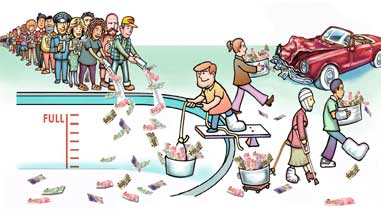While it may seem complex, insurance is really quite simple: The payments (or premiums) of the many pay for the losses of a few.
Your premiums go into a large pool, if you will, at your insurance company. The claims of the few are paid from that pool. Because there are more people contributing to the pool than there are making claims, there is always enough to pay the claims – even large single claims like when someone is permanently disabled as a result of a car collision, or many smaller claims like those resulting from a natural disaster. (The 1998 ice storm that hit parts of Ontario, Quebec and New Brunswick resulted in an estimated 700,000 claims for damage totalling $1.4 billion.) However, large disasters (such as the ice storm) do come close to emptying the pool.

Insurance for insurance companies
Even when the pool comes close to emptying, there is another pool from which insurance companies can draw to pay claims. Some of your premiums are used by your insurance company to buy reinsurance – insurance for insurance companies.
Sometimes losses are so big – like those resulting from an earthquake – that there is no way that an insurance company can cover the costs. Reinsurance is an extra layer of protection against large losses.
Annual replenishing
Your insurance is an annual contract, so the pool operates for only one year at a time.
Your premiums and the premiums of others are based on how much money the insurance companies think they will need to pay the coming year’s claims. Your premiums do not build up over the years – unlike the premiums for some types of life insurance.
How premiums are calculated
Within reasonable limits, some of which are prescribed by law, your premium is calculated to reflect the probability that you will make a claim – that is, that you will draw funds from the insurance pool. Those who are unlikely to draw from the pool pay less than those who are more likely to draw from it.
Insurers take many factors into consideration to determine the likelihood that you will make a claim. A common misconception is that a policyholder who has never made a claim should pay less, little or nothing for insurance. While it is true that past claims history is important, a more reliable indicator of how likely a person or business is to make a claim is the statistical group to which he/she/it belongs.
Industry earnings
Insurance companies generally do not make money on the premiums gathered from policyholders.
In 2005, insurance companies paid more than $21 billion in claims while taking in $35 billion in premiums. The difference between the premiums and claims, in this case $14 billion, is used by the companies to pay salaries and taxes ($6.2 billion in 2005), and to cover the overhead costs (such as electricity bills) of running a business. It is also used to pay the administrative costs of settling a claim.
Insurance pays for …
Insurance pays for only those types of losses described in your contract. It is very important that you read your policy and/or talk to your insurance broker about what you are covered for and what you’re not.
Insurance will not pay for every problem that you may encounter, nor is it a maintenance contract.
Insurance is generally intended – and priced accordingly – to help policyholders cope with the financial consequences of unpredictable events that are “sudden and accidental.”
If, for example, you live on a floodplain by a river, flooding of your property in the spring is not sudden or accidental; it is inevitable and, therefore, uninsurable.
Source: Insurance Bureau of Canada




